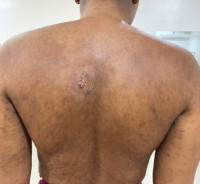Carbamazepine Induced Drug Reaction with Eosinophilia and Systemic Symptoms Syndrome
DOI:
https://doi.org/10.60787/tnhj.v22i4.612Keywords:
DRESS, Carbamazepine, eosinophilia, drug reactionAbstract
Background: Drug reaction with eosinophilia and systemic symptoms syndrome is a rare adverse, life threatening drug reaction caused by several drugs including Carbamazepine. The objective of this report is to create awareness of this life threatening reaction to a commonly prescribed drug for seizure disorders.
Methods: This is a case report of drug eosinophilia syndrome in a 33-year old female following clinical and laboratory evaluation at the skin clinic for generalized erythematous rashes following the use of Carbamazepine.
Results: She was found to have generalized, scaly, erythematous papules, patches and plagues. Laboratory results included blood eosinophilia, elevated liver enzymes and histopathology report of spongiotic dermatitis with eosinophilic infiltrates.
Conclusion: Drug reaction with eosinophilia and systemic symptoms syndrome can be caused by Carbamazepine. A diagnosis of this rare life threatening drug reaction should be suspected in patients presenting with generalized erythematous rashes following the use of Carbamazepine.
Downloads
References
Sukasem C, Chaichan C, Nakkrut T, Satapornpong P, Jaruthamsophon K, Jantararoungtong T et al. Association between HLA-B Alleles and Carbamazepine-Induced Maculopapular Exanthema and Severe Cutaneous Reactions in Thai Patients. J Immunol Res. 2018:2780272.
Cabañas R, Ramírez E, Sendagorta E, Alamar R, Barranco R, Blanca-López N et al. Spanish Guidelines for Diagnosis, Management, Treatment, and Prevention of DRESS Syndrome. J Investig Allergol Clin Immunol. 2020; 30:229-253.
Shiohara T, Mizukawa Y. Drug-induced hypersensitivity syndrome (DiHS)/drug reaction with eosinophilia and systemic symptoms (DRESS): An update in 2019. Allergol Int. 2019; 68:301-308.
Blumenthal KG, Youngster I, Rabideau DJ, Parker RA, Manning KS, Walensky RP, Nelson SB. Peripheral blood eosinophilia and hypersensitivity reactions among patients receiving outpatient parenteral antibiotics. J Allergy Clin Immunol. 2015;136:1288-94
Wolfson AR, Zhou L, Li Y, Phadke NA, Chow OA, Blumenthal KG. Drug Reaction with Eosinophilia and Systemic Symptoms (DRESS) Syndrome Identified in the Electronic Health Record Allergy Module. J Allergy Clin Immunol Pract. 2019;7:633-640
Karuppannasamy D, Andavar R, Arumugam J, Muthuvel K. DRESS Syndrome Secondary to Carbamazepine Therapy Presenting with Bilateral Acute Anterior Uveitis and Angle Closure Glaucoma. J Ophthalmic Vis Res. 2019;14:382-386
Vrinceanu D, Dumitru M, Stefan A, Neagos A, Musat G, Nica EA. Severe DRESS syndrome after carbamazepine intake in a case with multiple addictions: A case report. Exp Ther Med. 2020; 20:2377-2380.
Ksouda K, Affes H, Mahfoudh N, Chtourou L, Kammoun A, Charfi A et al. HLA-A*31:01 and carbamazepine-induced DRESS syndrom in a sample of North African population. Seizure. 2017; 53:42-46.
Omairi ELN, Abourazzak S, Chaouki S, Atmani S, Hida M. Drug Reaction with Eosinophilia and Systemic Symptom (DRESS) induced by carbamazepine: a case report and literature review. Pan Afr Med J. 2014; 18:19-22.
Sharma A, Joshi E, Gupta N, Joshi M. Carbamazepine-associated Drug Reaction with Eosinophilia and Systemic Symptoms Syndrome. J Pediatr Neurosci. 2021; 16:55-57.

Downloads
Published
Issue
Section
License
Copyright (c) 2022 Journal and Publisher

This work is licensed under a Creative Commons Attribution-NonCommercial-NoDerivatives 4.0 International License.
The Journal is owned, published and copyrighted by the Nigerian Medical Association, River state Branch. The copyright of papers published are vested in the journal and the publisher. In line with our open access policy and the Creative Commons Attribution License policy authors are allowed to share their work with an acknowledgement of the work's authorship and initial publication in this journal.
This is an open access journal which means that all content is freely available without charge to the user or his/her institution. Users are allowed to read, download, copy, distribute, print, search, or link to the full texts of the articles in this journal without asking prior permission from the publisher or the author.
The use of general descriptive names, trade names, trademarks, and so forth in this publication, even if not specifically identified, does not imply that these names are not protected by the relevant laws and regulations. While the advice and information in this journal are believed to be true and accurate on the date of its going to press, neither the authors, the editors, nor the publisher can accept any legal responsibility for any errors or omissions that may be made. The publisher makes no warranty, express or implied, with respect to the material contained herein.
TNHJ also supports open access archiving of articles published in the journal after three months of publication. Authors are permitted and encouraged to post their work online (e.g, in institutional repositories or on their website) within the stated period, as it can lead to productive exchanges, as well as earlier and greater citation of published work (See The Effect of Open Access). All requests for permission for open access archiving outside this period should be sent to the editor via email to editor@tnhjph.com.





